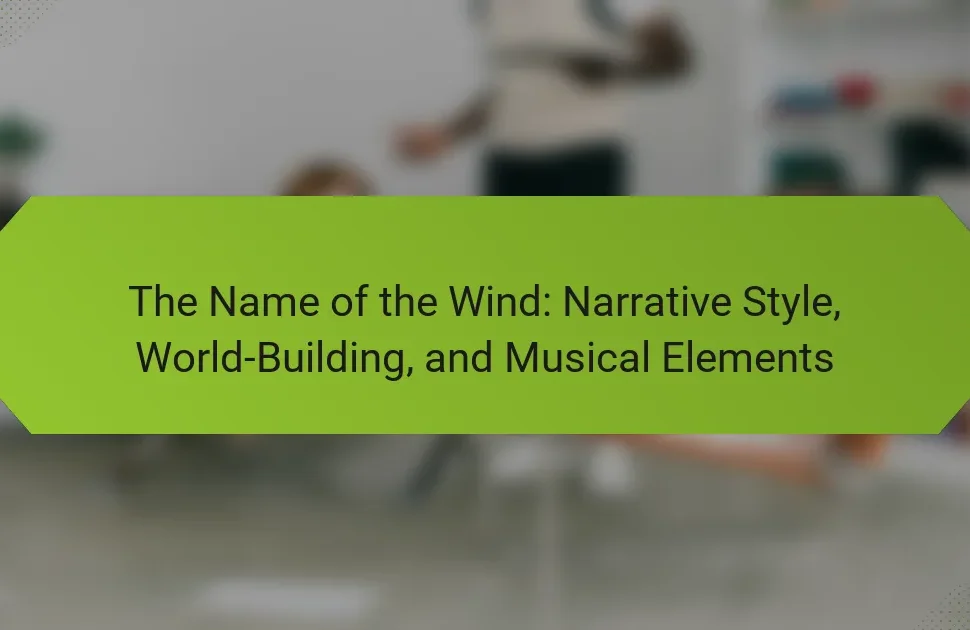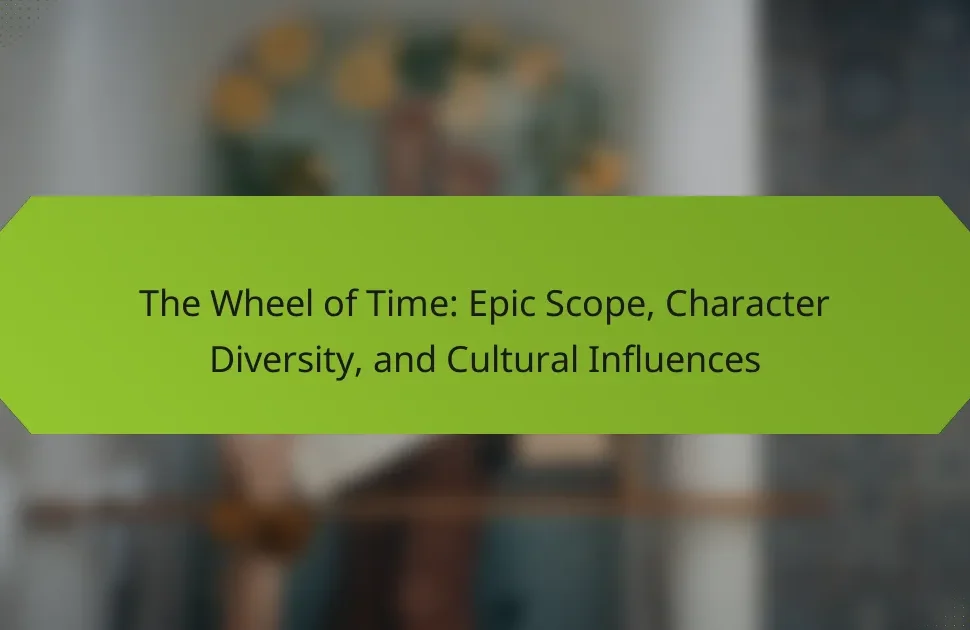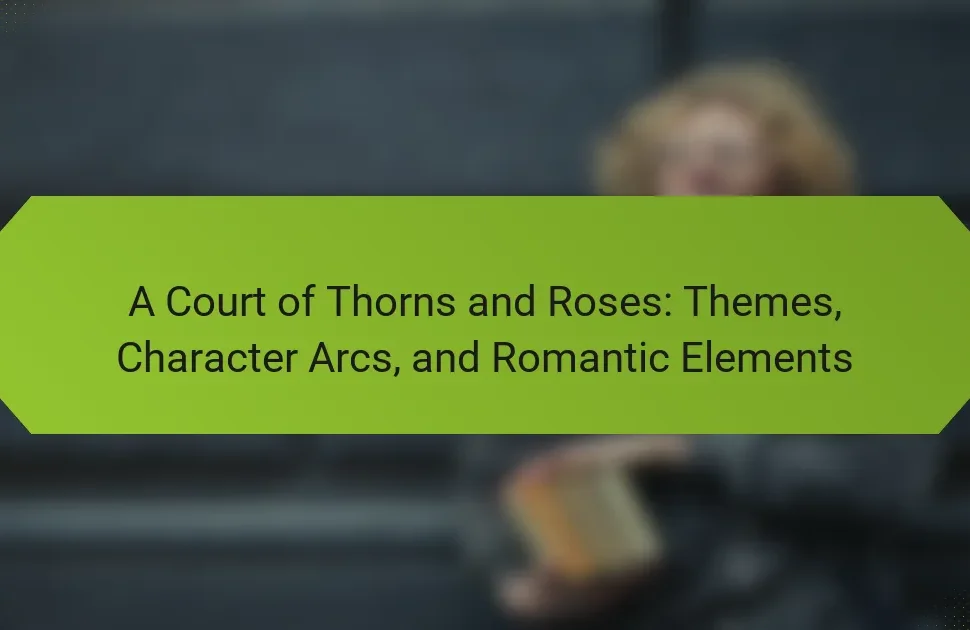The Hobbit is a rich narrative filled with adventure elements, character journeys, and mythical creatures. Key adventure components include Bilbo Baggins’ transformation and the quest to reclaim the Lonely Mountain. The character arcs highlight themes of bravery and friendship through encounters with dragons, trolls, and goblins. Additionally, the story’s narrative techniques enhance the immersive experience, contributing to its lasting impact across various adaptations.

What are the key adventure elements in The Hobbit?
The key adventure elements in The Hobbit include the hero’s journey, mythical creatures, and epic quests. Bilbo Baggins transforms from a reluctant participant to a courageous hero, facing challenges that test his character. Encounters with creatures like trolls, goblins, and Smaug the dragon highlight the fantastical elements. The quest to reclaim the Lonely Mountain adds depth to the narrative, emphasizing themes of bravery and friendship. Each adventure shapes Bilbo, showcasing his growth and resilience throughout the story.
How does the journey structure enhance the narrative?
The journey structure in “The Hobbit” enhances the narrative by providing a clear progression of character development and adventure. This framework allows for the exploration of themes such as courage and friendship, while the challenges faced by Bilbo Baggins reveal his growth from a timid hobbit to a brave hero. Each stage of the journey introduces unique mythical creatures, enriching the story’s fantasy elements and engaging the reader’s imagination. The contrast between Bilbo’s initial reluctance and his eventual bravery emphasizes the transformative power of adventure, making the narrative more compelling.
What role does conflict play in the adventure?
Conflict drives the adventure in “The Hobbit” by creating tension and propelling character development. It challenges Bilbo and his companions, revealing their strengths and weaknesses. The central conflict arises from the quest to reclaim the Lonely Mountain and its treasure, which pits the dwarves against various antagonists, including Smaug and the goblins. This struggle not only fuels the plot but also enriches themes of bravery, friendship, and growth. As a result, conflict is essential for transforming Bilbo from a timid hobbit into a courageous hero.
Which landscapes and settings are pivotal to the story?
The pivotal landscapes and settings in “The Hobbit” include the Shire, Rivendell, the Misty Mountains, Mirkwood Forest, and the Lonely Mountain. Each location plays a crucial role in shaping the characters’ journeys and the overall adventure.
The Shire represents home and comfort, contrasting with the dangers ahead. Rivendell serves as a refuge and a place of wisdom. The Misty Mountains present obstacles and challenges, while Mirkwood Forest introduces themes of darkness and enchantment. The Lonely Mountain symbolizes the ultimate quest and the desire for treasure.
These landscapes enhance the narrative by reflecting the characters’ growth and the adventure’s stakes. The distinct attributes of each setting contribute to the rich tapestry of the story.

How do character journeys shape the themes of The Hobbit?
Character journeys in The Hobbit significantly shape its themes of growth, bravery, and friendship. Bilbo Baggins transforms from a timid hobbit into a courageous hero, embodying the theme of self-discovery. His encounters with mythical creatures, such as Smaug and Gollum, highlight the theme of facing fears. Additionally, the camaraderie among the dwarves emphasizes the importance of teamwork and loyalty. These character arcs intertwine with the adventure elements, illustrating how personal growth occurs through challenges. Ultimately, the journey reinforces the message that true strength lies within, often revealed through unexpected trials.
What transformations do Bilbo Baggins and other characters undergo?
Bilbo Baggins undergoes significant transformation, evolving from a timid hobbit into a courageous adventurer. Other characters, like Thorin Oakenshield and Gollum, also experience profound changes, driven by their quests and internal struggles. Bilbo’s journey showcases growth through challenges, while Thorin’s arc highlights the corrupting nature of greed. Gollum’s duality reflects the conflict between his former self and the darker influences of the One Ring. Each character’s transformation emphasizes the themes of bravery, identity, and the impact of adventure on personal growth.
How do relationships influence character development?
Relationships significantly shape character development in “The Hobbit” by influencing growth and transformation. Bilbo Baggins evolves through his interactions with dwarves and Gandalf, revealing bravery and resourcefulness. These connections challenge his initial comfort and push him into adventure. As he faces trials alongside his companions, he learns the value of friendship and loyalty. The dynamics with characters like Thorin Oakenshield highlight themes of trust and leadership, showcasing how relationships can lead to personal growth and moral dilemmas. Ultimately, the journey reflects the profound impact of companionship on character evolution.
What are the motivations driving the characters’ journeys?
The characters’ journeys in “The Hobbit” are driven by diverse motivations including adventure, personal growth, and the quest for identity. Bilbo Baggins seeks to prove his courage and resourcefulness outside his comfort zone. Thorin Oakenshield’s journey is fueled by a desire to reclaim his homeland and restore his family’s honour. The dwarves collectively are motivated by the promise of treasure and the hope of restoring their legacy. Additionally, the presence of mythical creatures like Smaug adds urgency and danger, pushing characters toward their goals. Each character’s unique motivation shapes their development throughout the narrative.
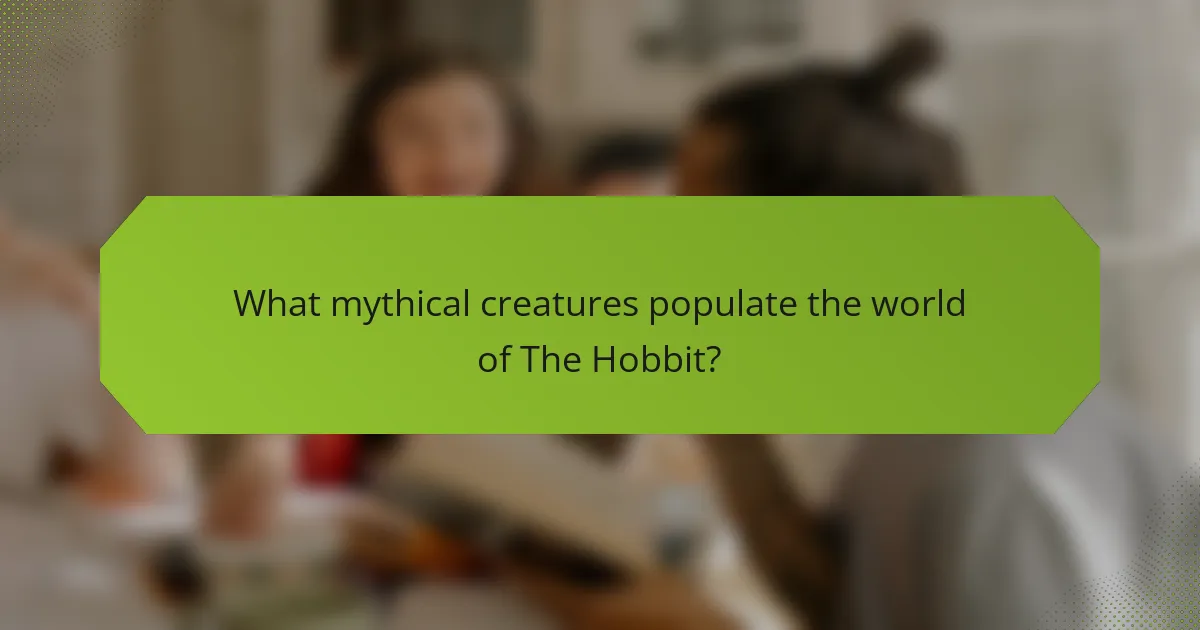
What mythical creatures populate the world of The Hobbit?
The world of The Hobbit features several mythical creatures, including dragons, trolls, goblins, and elves. Each creature contributes to the rich tapestry of adventure and conflict in the story. Dragons, like Smaug, are unique for their intelligence and greed, while trolls are known for their brute strength and foolishness. Goblins inhabit dark caves and are often antagonistic, and elves embody grace and wisdom, showcasing rare attributes in their longevity and magical abilities. These creatures enhance the themes of bravery and friendship throughout the narrative.
How do these creatures contribute to the story’s themes?
Mythical creatures in “The Hobbit” significantly enhance the story’s themes of adventure, courage, and friendship. They embody challenges that characters must overcome, illustrating personal growth and transformation. For instance, the dragon Smaug represents greed and destruction, driving Bilbo’s journey toward bravery and resourcefulness. Additionally, creatures like the elves and dwarves highlight themes of unity and conflict, showcasing diverse perspectives in the quest for a common goal. Each creature contributes uniquely to the narrative, reinforcing the overarching message of self-discovery through adversity.
Which creatures are unique to the narrative and why?
The unique creatures in “The Hobbit” include Smaug, the dragon, and the trolls. Smaug is notable for his intelligence and treasure hoarding, while the trolls provide comic relief with their foolishness. These unique traits enhance the narrative’s adventure and thematic depth.
What are the cultural significances of these mythical beings?
The cultural significances of mythical beings in “The Hobbit” reflect deep-rooted themes of heroism, morality, and the struggle between good and evil. These creatures symbolize various aspects of human experience, such as courage through the character of Bilbo Baggins, who embarks on a transformative journey.
Elves, for instance, represent wisdom and grace, while dwarves embody resilience and loyalty. The presence of dragons, particularly Smaug, illustrates greed and destruction, serving as a cautionary tale about the consequences of avarice.
These mythical beings enhance the narrative by enriching the cultural landscape of Middle-earth, inviting readers to explore complex moral dilemmas and the importance of friendship and bravery in overcoming adversity. The interplay between these entities and their attributes deepens the reader’s understanding of the story’s themes.

How does The Hobbit reflect universal themes of adventure and heroism?
The Hobbit reflects universal themes of adventure and heroism through its character journeys and mythical creatures. Bilbo Baggins’ transformation from a timid hobbit to a courageous hero exemplifies the adventure theme. His encounters with dragons, trolls, and elves highlight the challenges that define heroism. The journey emphasizes personal growth, showcasing how facing fears leads to bravery. Additionally, the fellowship of characters illustrates the importance of friendship and loyalty in overcoming obstacles, reinforcing these timeless themes.
What lessons can be learned from Bilbo’s character arc?
Bilbo’s character arc teaches the importance of personal growth, bravery, and the value of home. Initially, Bilbo is a reluctant participant in adventure, showcasing his comfort in routine. As the journey progresses, he demonstrates increasing courage and resourcefulness, ultimately embracing his role as a hero. This transformation highlights the idea that true strength often emerges in unexpected circumstances. Additionally, Bilbo’s journey emphasizes the significance of friendship and loyalty, as his relationships with the dwarves shape his development. Overall, his arc illustrates that adventure can lead to profound self-discovery and change.
How does the story’s moral compass guide the characters?
The story’s moral compass guides characters by shaping their decisions and growth throughout their journeys. In “The Hobbit,” Bilbo Baggins evolves from a hesitant hobbit into a courageous hero, driven by values like friendship and loyalty. Gandalf’s mentorship reinforces these morals, influencing Bilbo’s choices during critical moments. Additionally, the interactions with mythical creatures, such as Smaug, emphasize themes of bravery and responsibility, further guiding character development. Ultimately, the moral compass serves as a framework for understanding the characters’ transformations and their relationships with one another.
Which elements resonate across different cultures?
Adventure elements, character journeys, and mythical creatures in “The Hobbit” resonate universally through themes of heroism, friendship, and transformation. These themes reflect shared human experiences across cultures.
The journey of Bilbo Baggins exemplifies the hero’s quest, a narrative found in various cultures. His transformation from a timid hobbit to a courageous adventurer mirrors the universal theme of personal growth.
Mythical creatures in the story, such as dragons and trolls, symbolize challenges faced in life. These creatures often represent fears or obstacles, a concept prevalent in many cultural myths.
In summary, “The Hobbit” encapsulates adventure and personal growth, resonating with diverse cultural values through its universal themes and relatable character journeys.
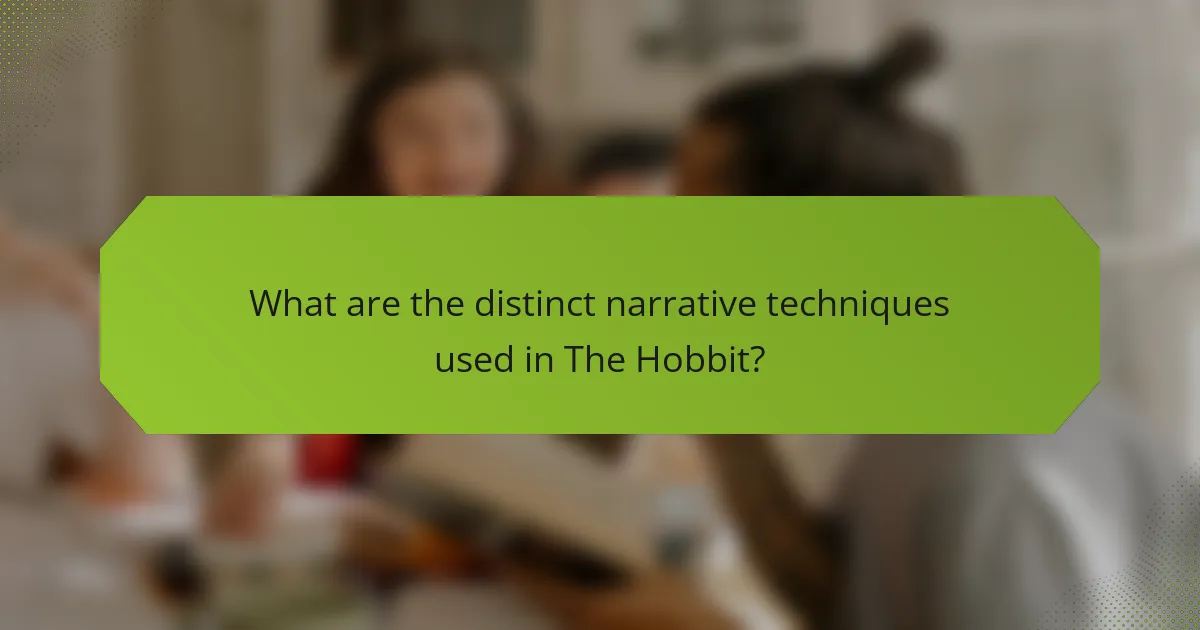
What are the distinct narrative techniques used in The Hobbit?
The Hobbit employs distinct narrative techniques, including third-person narration, rich descriptive imagery, and dialogue. These techniques enhance the adventure elements and character journeys, creating an immersive experience. Third-person narration provides a broader perspective on the characters and events, allowing readers to connect with multiple viewpoints. Rich descriptive imagery vividly portrays the mythical creatures and landscapes, deepening the sense of wonder. Dialogue reveals character personalities and motivations, driving the plot forward. Together, these techniques contribute to the story’s engaging and fantastical nature.
How does Tolkien’s writing style enhance the adventure experience?
Tolkien’s writing style significantly enhances the adventure experience in “The Hobbit” through vivid imagery, rich character development, and intricate world-building. His descriptive language immerses readers in Middle-earth, making landscapes and creatures come alive. The character journeys, particularly Bilbo’s transformation from a timid hobbit to a courageous hero, resonate deeply with readers, showcasing themes of growth and bravery. Mythical creatures, such as dragons and trolls, are depicted with unique attributes that add excitement and tension to the narrative. This combination of engaging prose and imaginative elements creates a captivating adventure that draws readers into an unforgettable journey.
What role does humor play in the storytelling?
Humor plays a significant role in storytelling by enhancing engagement and providing relief from tension. In “The Hobbit,” humor balances the adventure’s darker elements, making characters relatable. For example, Bilbo’s witty remarks lighten intense moments, fostering connection with readers. This use of humor highlights the unique attribute of character development, showcasing Bilbo’s growth from a hesitant hobbit to a clever hero. As a result, humor enriches the narrative, maintaining a captivating pace while deepening emotional resonance.
How does symbolism enrich the narrative depth?
Symbolism enriches narrative depth by adding layers of meaning and emotional resonance. In “The Hobbit,” symbols like the One Ring represent power and corruption, influencing character journeys. The journey of Bilbo Baggins symbolizes personal growth and bravery, showcasing transformation through adventure. Mythical creatures, such as dragons, symbolize greed and destruction, enhancing the stakes of the narrative. These elements collectively deepen the reader’s engagement, making themes more relatable and profound.
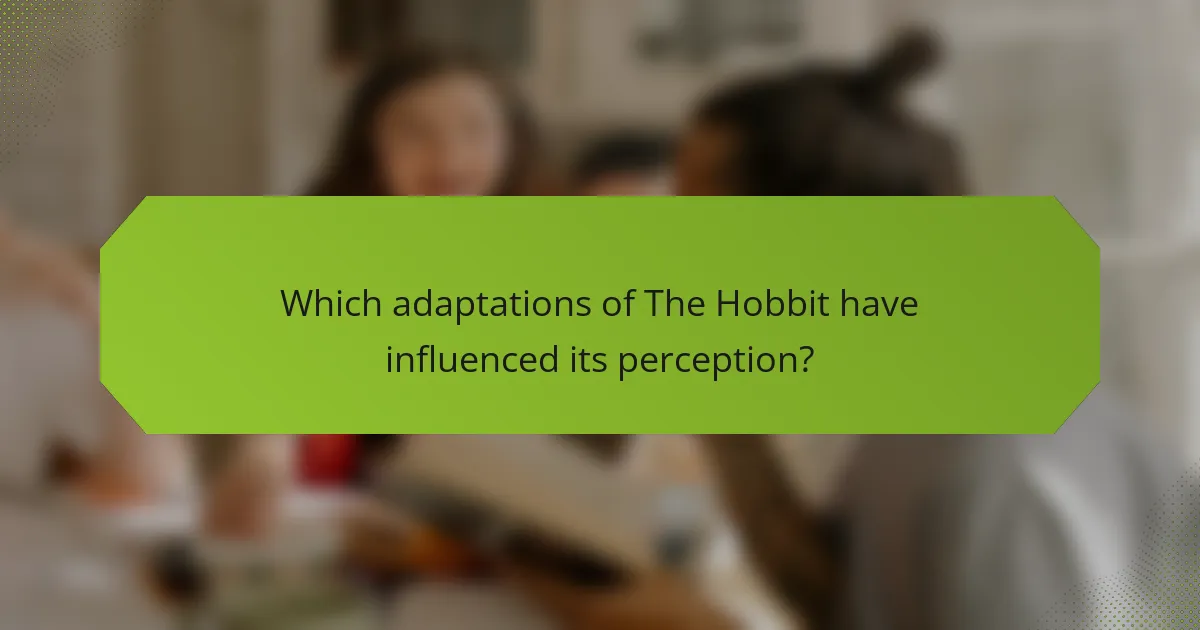
Which adaptations of The Hobbit have influenced its perception?
Various adaptations of The Hobbit have significantly influenced its perception, particularly through film, animation, and stage. The 2001-2014 film series directed by Peter Jackson introduced visual grandeur and expanded character backstories, reshaping audience engagement. Animated adaptations, such as the 1977 Rankin/Bass film, showcased a whimsical interpretation, appealing to younger audiences. Stage adaptations have emphasized themes of adventure and heroism, allowing for diverse interpretations. Each adaptation highlights unique attributes, such as character depth and visual storytelling, contributing to the evolving legacy of this classic tale.
How do film adaptations differ from the original text?
Film adaptations of “The Hobbit” often differ significantly from the original text in elements such as adventure pacing, character development, and the portrayal of mythical creatures. The films emphasize action and visual spectacle, sometimes at the expense of deeper character journeys found in the book. For example, the character of Bilbo Baggins experiences more internal conflict and growth in the text, while the films highlight external challenges. Additionally, the adaptation introduces new characters and subplots that are not present in the original narrative, altering the storyline’s focus. The mythical creatures, such as trolls and dragons, are rendered with advanced CGI, enhancing their presence but sometimes overshadowing their thematic significance in the book. Overall, these adaptations prioritize cinematic experience over literary fidelity.
What impact have video games had on the franchise?
Video games have significantly enhanced “The Hobbit” franchise by expanding its narrative and engaging audiences. They introduce interactive elements that allow players to experience character journeys and mythical creatures firsthand. This interactivity deepens emotional connections to the story and its characters. Additionally, video games have introduced unique gameplay mechanics, such as puzzle-solving and exploration, which complement the franchise’s themes of adventure and discovery. As a result, they have attracted a broader audience and revitalized interest in Tolkien’s world.
How do various adaptations reflect cultural interpretations?
Various adaptations of “The Hobbit” showcase cultural interpretations through unique character portrayals and adventure elements. Each adaptation reflects its cultural context, emphasizing values and themes relevant to its audience. For instance, the animated version highlights whimsy, while Peter Jackson’s films incorporate darker tones and complex character arcs. These differences reveal how societies perceive heroism, friendship, and the struggle against evil. Additionally, mythical creatures like Smaug represent cultural fears and aspirations, adapting to resonate with different generations. Overall, adaptations serve as mirrors of cultural values and storytelling traditions.
What are best practices for engaging with The Hobbit’s themes?
To engage effectively with the themes of The Hobbit, focus on the adventure elements, character journeys, and mythical creatures. Emphasize the transformative journeys of characters like Bilbo Baggins, highlighting growth through challenges. Explore the significance of adventure as a catalyst for personal development. Discuss the role of mythical creatures, such as dragons and trolls, in enriching the narrative and symbolizing various themes like greed and bravery. Encourage discussions that connect these elements to broader life lessons and moral values, fostering deeper understanding and appreciation of the story’s richness.

